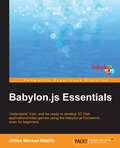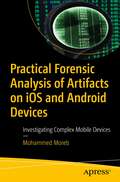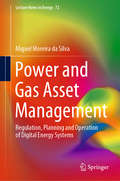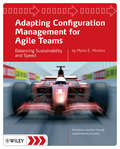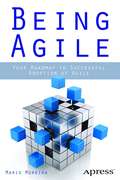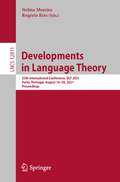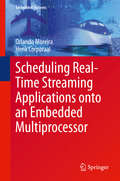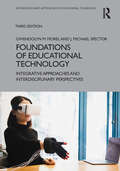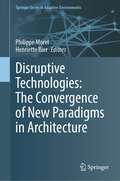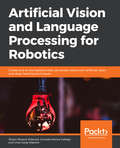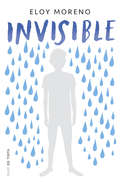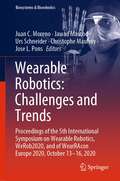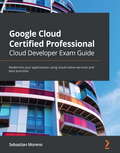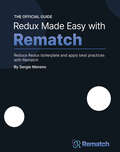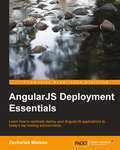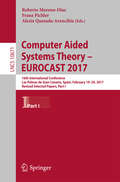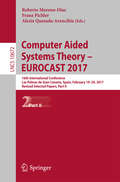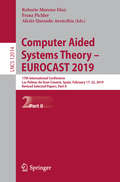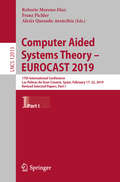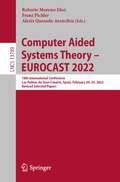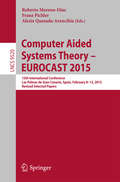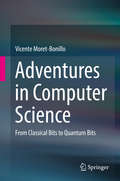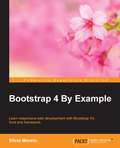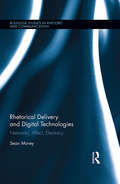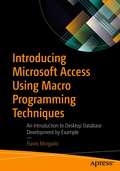- Table View
- List View
Babylon.js Essentials
by Julien Moreau-MathisUnderstand, train, and be ready to develop 3D Web applications/video games using the Babylon.js framework, even for beginners About This Book * Understand the basics of 3D (along with the theory) before practicing * Each mini-project provides previous features, alongside the new feature you are learning, to supply the examples * Learn from the best of the best, a developer at Microsoft, France Who This Book Is For Babylon.JS Essentials is intended for developers who want to enter the world of 3D development for the Web, or developers who want to add the Babylon.js framework to their skill set. The notion of Oriented Object Programming would be helpful to understand the architecture of the Babylon.js framework. Also, a familiarity with Web development would be useful, to understand the principles used. What You Will Learn * Understand what the TypeScript language is and its benefits (compared to JavaScript) in large projects such as 3D engines * Learn the basics of 3D using Babylon.js without too much theory but with an emphasis on practice, for a better understanding of the architecture * Know the usage of Material--a fundamental principle of 3D engines in Babylon.js--and then customize the appearance of 3D objects * Integrate collisions and physics in gameplay. Understand the notion of impostor for physics simulation * Manage, create, and spatialize audio tracks in 3D scenes * Go further with the Babylon.js framework to create actions on events * Create rendering effects provided by the Babylon.js framework, such as post-processes In Detail Are you familiar with HTML5? Do you want to build exciting games and Web applications? Then explore the exciting world of game and Web development with one of the best frameworks out there: Babylon.JS. Starting from the beginning, the book introduces the required basics for 3D development and the knowledge you need to use the Babylon.js framework. It focuses on the simplicity provided by Babylon.js and uses a combination of theory and practice. All the chapters are provided with example files ready to run; each example file provides the previously learned features of the framework. Finally, developers will be ready to easily understand new features added to the framework in the future. Style and approach The book is a comprehensive guide packed with ready-to-run examples with a mix of theory and practice.
Practical Forensic Analysis of Artifacts on iOS and Android Devices: Investigating Complex Mobile Devices
by Mohammed MorebLeverage foundational concepts and practical skills in mobile device forensics to perform forensically sound criminal investigations involving the most complex mobile devices currently available on the market. Using modern tools and techniques, this book shows you how to conduct a structured investigation process to determine the nature of the crime and to produce results that are useful in criminal proceedings. You’ll walkthrough the various phases of the mobile forensics process for both Android and iOS-based devices, including forensically extracting, collecting, and analyzing data and producing and disseminating reports. Practical cases and labs involving specialized hardware and software illustrate practical application and performance of data acquisition (including deleted data) and the analysis of extracted information. You'll also gain an advanced understanding of computer forensics, focusing on mobile devices and other devices not classifiable as laptops, desktops, or servers. This book is your pathway to developing the critical thinking, analytical reasoning, and technical writing skills necessary to effectively work in a junior-level digital forensic or cybersecurity analyst role. What You'll LearnAcquire and investigate data from mobile devices using forensically sound, industry-standard toolsUnderstand the relationship between mobile and desktop devices in criminal and corporate investigationsAnalyze backup files and artifacts for forensic evidenceWho This Book Is ForForensic examiners with little or basic experience in mobile forensics or open source solutions for mobile forensics. The book will also be useful to anyone seeking a deeper understanding of mobile internals.
Power and Gas Asset Management: Regulation, Planning and Operation of Digital Energy Systems (Lecture Notes in Energy #72)
by Miguel Moreira da SilvaThis book offers meaningful insights into an impending challenge for the energy industry, namely the increasing role of asset management amongst the utilities’ core operations. In the aftermath of energy digitalization, power and gas companies will be able to seize asset productivity—through risk-based operation and maintenance—and better balance capital and operational expenditures. By addressing the asset management of both power and gas infrastructures, and by adopting a comprehensive approach—including regulation and business models, as well as a solid technology background—this book offers a unique perspective on the energy utilities’ transformation journey and the road to optimal decision-making for both asset portfolio expansion and replacement. The asset management end-to-end mission requires appropriate internal governance—depending on the business framework—and the development of decision aid models (for asset replacement and maintenance), supported on probabilistic risk and reliability indexes. This book advocates systematically digitalizing the power and gas assets, addressing both data governance and infrastructure, alongside real-time equipment condition monitoring. It also provides a meaningful methodology for designing data-centric asset management and predictive operation and maintenance, using artificial intelligence and engineering-based approaches. As such, it provides valuable strategy, methods and models—illustrated by case studies and proofs of concept—for a wide range of stakeholders, including utilities and industry professionals, regulators, policy-makers, researchers and students.
Adapting Configuration Management for Agile Teams
by Mario E. MoreiraAdapting Configuration Management for Agile Teams provides very tangible approaches on how Configuration Management with its practices and infrastructure can be adapted and managed in order to directly benefit agile teams. Written by Mario E. Moreira, author of Software Configuration Management Implementation Roadmap, columnist for CM Crossroads online community and writer for the Agile Journal, this unique book provides concrete guidance on tailoring CM for Agile projects without sacrificing the principles of Configuration Management.
Being Agile: Your Roadmap to Successful Adoption of Agile
by Mario E. MoreiraBeing Agileis your roadmap to successfully transforming your organization to an Agile culture. Veteran agile coach Mario Moreira teaches new adopters how to implement a robust Agile framework to derive from it the maximum business benefit in terms of customer value, revenue, and employee engagement. Agile is a ubiquitous watchword in the corporate world, but only a minority of companies understand and practice what they pay lip service to. Too many content themselves with half-baked approximations such as Fragile (fragile Agile), ScrumBut (Scrum but not the practices), and Scrum Fall (mini-waterfalls in the sprints). Moreira shows maturing early adopters how to bridge the chasm between going through the motions of doing Agile and genuinelybeing Agile. After a high-level synopsis of Agile's values and principles, methodologies (including Scrum, Kanban, DSDM, Leam, VFQ, and XP), and roles, Moreira plunges into the nitty-gritty of how to apply the ready, implement, coach, and hone (RICH) deployment model to all phases of a project in such a way as to embody and inculcate agile values and principles at the team level and promote agile transformation across your organization's culture. "
Developments in Language Theory: 25th International Conference, DLT 2021, Porto, Portugal, August 16–20, 2021, Proceedings (Lecture Notes in Computer Science #12811)
by Nelma Moreira Rogério ReisThis book constitutes the proceedings of the 25th International Conference on Developments in Language Theory, DLT 2021, which was held in Porto, Portugal, during August 16-20, 2021. The conference took place in an hybrid format with both in-person and online participation.The 27 full papers included in these proceedings were carefully reviewed and selected from 48 submissions. The DLT conference series provides a forum for presenting current developments in formal languages and automata. Its scope is very general and includes, among others, the following topics and areas: grammars, acceptors and transducers for words, trees and graphs; algebraic theories of automata; algorithmic, combinatorial, and algebraic properties of words and languages; variable length codes; symbolic dynamics; cellular automata; polyominoes and multidimensional patterns; decidability questions; image manipulation and compression; efficient text algorithms; relationships to cryptography, concurrency, complexity theory, and logic; bio-inspired computing; quantum computing. The book also includes 3 invited talks in full paper length.
Scheduling Real-Time Streaming Applications onto an Embedded Multiprocessor
by Orlando Moreira Henk CorporaalThis book provides a comprehensive overview of the state-of-the-art, data flow-based techniques for the analysis, modeling and mapping technologies of concurrent applications on multi-processors The authors present a flow for designing embedded hard/firm real-time multiprocessor streaming applications, based on data flow formalisms, with a particular focus on wireless modem applications. Architectures are described for the design tools and run-time scheduling and resource management of such a platform.
Foundations of Educational Technology: Integrative Approaches and Interdisciplinary Perspectives (Interdisciplinary Approaches to Educational Technology)
by Gwendolyn M. Morel J. Michael SpectorFoundations of Educational Technology offers a fresh, interdisciplinary, problem-centered approach to educational technology, learning design, and instructional systems development. As the implementation of online, blended, hybrid, mobile, open, and adaptive learning systems rapidly expands, emerging tools such as learning analytics, artificial intelligence, mixed realities, serious games, and micro-credentialing are promising more complex and personalized learning experiences. This book provides faculty and graduate students with a conceptual, empirical, and practical basis for the effective use of these systems across contexts, integrating essential theories from the fields of human performance, learning and development, information and communications, and instructional design. Key additions to this revised and expanded third edition include coverage of the latest learning technologies, research from educational neuroscience, discussions about security and privacy, new attention to diversity, equity, and inclusion, updated activities, support materials, references, and more.
Disruptive Technologies: The Convergence of New Paradigms in Architecture (Springer Series in Adaptive Environments)
by Philippe Morel Henriette BierThrough a series of highly speculative contributions by both leading and highly acclaimed practitioners and theorists, this book gives a new comprehensive overview of architectures’ most recent practical and theoretical developments. While a few chapters are mostly dedicated to a historical analysis of how we got to experience a new technological reality in architecture and beyond, all chapters including the most forward looking, have in common their rigorous understanding of history as a pool of radical experiments, whether one speaks of the history of architecture, or of sociology, technology, and science. Disruptive Technologies: The Convergence of New Paradigms in Architecture is required reading for anybody student, practitioner, and educator who wants to do serious research in architecture and all disciplines dealing with the shaping of our environment, beyond the important but restricted domain of computational architectural design.Additional multimedia content via app: download the SN More Media app for free, scan a link with play button and access to the Additional Contents directly on your smartphone or tablet.
Artificial Vision and Language Processing for Robotics: Create end-to-end systems that can power robots with artificial vision and deep learning techniques
by Álvaro Morena Alberola Gonzalo Molina Gallego Unai Garay MaestreCreate end-to-end systems that can power robots with artificial vision and deep learning techniquesKey FeaturesStudy ROS, the main development framework for robotics, in detailLearn all about convolutional neural networks, recurrent neural networks, and roboticsCreate a chatbot to interact with the robotBook DescriptionArtificial Vision and Language Processing for Robotics begins by discussing the theory behind robots. You'll compare different methods used to work with robots and explore computer vision, its algorithms, and limits. You'll then learn how to control the robot with natural language processing commands. You'll study Word2Vec and GloVe embedding techniques, non-numeric data, recurrent neural network (RNNs), and their advanced models. You'll create a simple Word2Vec model with Keras, as well as build a convolutional neural network (CNN) and improve it with data augmentation and transfer learning. You'll study the ROS and build a conversational agent to manage your robot. You'll also integrate your agent with the ROS and convert an image to text and text to speech. You'll learn to build an object recognition system using a video.By the end of this book, you'll have the skills you need to build a functional application that can integrate with a ROS to extract useful information about your environment.What you will learnExplore the ROS and build a basic robotic systemUnderstand the architecture of neural networksIdentify conversation intents with NLP techniquesLearn and use the embedding with Word2Vec and GloVeBuild a basic CNN and improve it using generative modelsUse deep learning to implement artificial intelligence(AI)and object recognitionDevelop a simple object recognition system using CNNsIntegrate AI with ROS to enable your robot to recognize objectsWho this book is forArtificial Vision and Language Processing for Robotics is for robotics engineers who want to learn how to integrate computer vision and deep learning techniques to create complete robotic systems. It will prove beneficial to you if you have working knowledge of Python and a background in deep learning. Knowledge of the ROS is a plus.
Invisible
by Eloy MorenoEmotiva, conmovedora, diferente... Invisible narra, a través de los ojos de un niño, una historia que podría ser la de cualquiera de nosotros. ¿Quién no ha deseado alguna vez ser invisible? ¿Quién no ha deseado alguna vez dejar de serlo? El problema es que nunca he llegado a controlar bien ese poder: A veces, cuando más ganas tenía de ser invisible, era cuando más gente me veía, y en cambio, cuando deseaba que todos me vieran, era cuando a mi cuerpo le daba por desaparecer.
Wearable Robotics: Proceedings of the 5th International Symposium on Wearable Robotics, WeRob2020, and of WearRAcon Europe 2020, October 13–16, 2020 (Biosystems & Biorobotics #27)
by Juan C. Moreno Jawad Masood Urs Schneider Christophe Maufroy Jose L. PonsThis book reports on advanced topics in the areas of wearable robotics research and practice. It focuses on new technologies, including neural interfaces, soft wearable robots, sensors and actuators technologies, discussing industrially and medically-relevant issues, as well as legal and ethical aspects. It covers exemplary case studies highlighting challenges related to the implementation of wearable robots for different purposes, and describing advanced solutions. Based on the 5th International Symposium on Wearable Robotics, WeRob2020, and on WearRacon Europe 2020, which were both held online on October 13-16, 2020, the book addresses a large audience of academics and professionals working in for the government, in the industry, and in medical centers, as well as end-users alike. By merging together engineering, medical, ethical and industrial perspectives, it offers a multidisciplinary, timely snapshot of the field of wearable technologies.
Google Cloud Certified Professional Cloud Developer Exam Guide: Modernize your applications using cloud-native services and best practices
by Sebastian MorenoDiscover how Google Cloud services can help you to reduce operational tasks and focus on delivering business value with your applicationsKey FeaturesDesign, develop, and deploy end-to-end cloud-native applications using Google Cloud servicesPrepare for the GCP developer exam with the help of a fictitious business case and a Q&A sectionGet hands-on with implementing code examples of different GCP services in your applicationsBook DescriptionGoogle Cloud Platform is one of the three major cloud providers in the industry, exhibiting great leadership in application modernization and data management. This book provides a comprehensive introduction for those who are new to cloud development and shows you how to use the tools to create cloud-native applications by integrating the technologies used by Google. The book starts by taking you through the basic programming concepts and security fundamentals necessary for developing in Google Cloud. You'll then discover best practices for developing and deploying applications in the cloud using different components offered by Google Cloud Platform such as Cloud Functions, Google App Engine, Cloud Run, and other GCP technologies. As you advance, you'll learn the basics of cloud storage and choosing the best options for storing different kinds of data as well as understand what site reliability engineers do. In the last part, you'll work on a sample case study of Hip Local, a community application designed to facilitate communication between people nearby, created by the Google Cloud team. By the end of this guide, you'll have learned how to design, develop, and deploy an end-to-end application on the Google Cloud Platform.What you will learnGet to grips with the fundamentals of Google Cloud Platform developmentDiscover security best practices for applications in the cloudFind ways to create and modernize legacy applicationsUnderstand how to manage data and databases in Google CloudExplore best practices for site reliability engineering, monitoring, logging, and debuggingBecome well-versed with the practical implementation of GCP with the help of a case studyWho this book is forThis book is for cloud engineers or developers working or starting to work on Google Cloud Platform and looking to take advantage of cloud-native applications. You'll also find this book useful if you are preparing for the GCP developer exam.
Redux Made Easy with Rematch: Reduce Redux boilerplate and apply best practices with Rematch
by Sergio MorenoDiscover the power of Rematch and its plugins by building a real-world application from scratchKey FeaturesGet to grips with the capabilities of Rematch quickly as you build applicationsLearn to use Rematch and its plugins to simplify everyday tasksTake total control of the application state and manage its scalability using RematchBook DescriptionRematch is Redux best practices without the boilerplate. This book is an easy-to-read guide for anyone who wants to get started with Redux, and for those who are already using it and want to improve their codebase.Complete with hands-on tutorials, projects, and self-assessment questions, this easy-to-follow guide will take you from the simplest through to the most complex layers of Rematch. You'll learn how to migrate from Redux, and write plugins to set up a fully tested store by integrating it with vanilla JavaScript, React, and React Native. You'll then build a real-world application from scratch with the power of Rematch and its plugins. As you advance, you'll see how plugins extend Rematch functionalities, understanding how they work and help to create a maintainable project. Finally, you'll analyze the future of Rematch and how the frontend ecosystem is becoming easier to use and maintain with alternatives to Redux.By the end of this book, you'll be able to have total control of the application state and use Rematch to manage its scalability with simplicity.What you will learnUnderstand the principal concepts of Flux and ReduxFind out what the main problems are that Rematch solvesBecome familiar with the Rematch ecosystemDevelop an application using Rematch and React togetherWrite unit and integration tests to get 100% test coverage of your programs with RematchCreate a React Native app with Rematch and ExpoPersist data with redux-persist and RematchBuild a Rematch plugin from scratchWho this book is forThis book is for React and Redux users looking for better alternatives for Redux. Familiarity with JavaScript, React, and Redux will help you make the most of this book.
AngularJS Deployment Essentials
by Zachariah MorenoIf you are a web developer, this handy guide will empower you to quickly learn the fundamentals of AngularJS development and deployment.
Computer Aided Systems Theory – EUROCAST 2017: 16th International Conference, Las Palmas de Gran Canaria, Spain, February 19-24, 2017, Revised Selected Papers, Part I (Lecture Notes in Computer Science #10671)
by Roberto Moreno-Díaz Franz Pichler Alexis Quesada-ArencibiaThe two-volume set LNCS 10671 and 10672 constitutes the thoroughly refereed proceedings of the 16th International Conference on Computer Aided Systems Theory, EUROCAST 2017, held in Las Palmas de Gran Canaria, Spain, in February 2017. The 117 full papers presented were carefully reviewed and selected from 160 submissions. The papers are organized in topical sections on: pioneers and landmarks in the development of information and communication technologies; systems theory, socio-economic systems and applications; theory and applications of metaheuristic algorithms; stochastic models and applications to natural, social and technical systems; model-based system design, verification and simulation; applications of signal processing technology; algebraic and combinatorial methods in signal and pattern analysis; computer vision, deep learning and applications; computer and systems based methods and electronics technologies in medicine; intelligent transportation systems and smart mobility.
Computer Aided Systems Theory – EUROCAST 2017: 16th International Conference, Las Palmas de Gran Canaria, Spain, February 19-24, 2017, Revised Selected Papers, Part II (Lecture Notes in Computer Science #10672)
by Roberto Moreno-Díaz Franz Pichler Alexis Quesada-ArencibiaThe two-volume set LNCS 10671 and 10672 constitutes the thoroughly refereed proceedings of the 16th International Conference on Computer Aided Systems Theory, EUROCAST 2017, held in Las Palmas de Gran Canaria, Spain, in February 2017. The 117 full papers presented were carefully reviewed and selected from 160 submissions. The papers are organized in topical sections on: pioneers and landmarks in the development of information and communication technologies; systems theory, socio-economic systems and applications; theory and applications of metaheuristic algorithms; stochastic models and applications to natural, social and technical systems; model-based system design, verification and simulation; applications of signal processing technology; algebraic and combinatorial methods in signal and pattern analysis; computer vision, deep learning and applications; computer and systems based methods and electronics technologies in medicine; intelligent transportation systems and smart mobility.
Computer Aided Systems Theory – EUROCAST 2019: 17th International Conference, Las Palmas de Gran Canaria, Spain, February 17–22, 2019, Revised Selected Papers, Part II (Lecture Notes in Computer Science #12014)
by Roberto Moreno-Díaz Franz Pichler Alexis Quesada-ArencibiaThe two-volume set LNCS 12013 and 12014 constitutes the thoroughly refereed proceedings of the 17th International Conference on Computer Aided Systems Theory, EUROCAST 2019, held in Las Palmas de Gran Canaria, Spain, in February 2019. The 123 full papers presented were carefully reviewed and selected from 172 submissions. The papers are organized in the following topical sections: Part I: systems theory and applications; pioneers and landmarks in the development of information and communication technologies; stochastic models and applications to natural, social and technical systems; theory and applications of metaheuristic algorithms; model-based system design, verification and simulation. Part II: applications of signal processing technology; artificial intelligence and data mining for intelligent transportation systems and smart mobility; computer vision, machine learning for image analysis and applications; computer and systems based methods and electronic technologies in medicine; advances in biomedical signal and image processing; systems concepts and methods in touristic flows; systems in industrial robotics, automation and IoT.
Computer Aided Systems Theory – EUROCAST 2019: 17th International Conference, Las Palmas de Gran Canaria, Spain, February 17–22, 2019, Revised Selected Papers, Part I (Lecture Notes in Computer Science #12013)
by Roberto Moreno-Díaz Franz Pichler Alexis Quesada-ArencibiaThe two-volume set LNCS 12013 and 12014 constitutes the thoroughly refereed proceedings of the 17th International Conference on Computer Aided Systems Theory, EUROCAST 2019, held in Las Palmas de Gran Canaria, Spain, in February 2019. The 123 full papers presented were carefully reviewed and selected from 172 submissions. The papers are organized in the following topical sections: Part I: systems theory and applications; pioneers and landmarks in the development of information and communication technologies; stochastic models and applications to natural, social and technical systems; theory and applications of metaheuristic algorithms; model-based system design, verification and simulation. Part II: applications of signal processing technology; artificial intelligence and data mining for intelligent transportation systems and smart mobility; computer vision, machine learning for image analysis and applications; computer and systems based methods and electronic technologies in medicine; advances in biomedical signal and image processing; systems concepts and methods in touristic flows; systems in industrial robotics, automation and IoT.
Computer Aided Systems Theory – EUROCAST 2022: 18th International Conference, Las Palmas de Gran Canaria, Spain, February 20–25, 2022, Revised Selected Papers (Lecture Notes in Computer Science #13789)
by Roberto Moreno-Díaz Franz Pichler Alexis Quesada-ArencibiaThis book constitutes the refereed proceedings of the 18th International Conference on Computer-Aided Systems Theory, EUROCAST 2022, held in Las Palmas de Gran Canaria, Spain, during February 20–25, 2022. The 77 full papers included in this book were carefully reviewed and selected from 110 submissions. They were organized in topical sections as follows: Systems Theory and Applications, Theory and Applications of Metaheuristic Algorithms, Model-Based System Design, Verification and Simulation, Applications of Signal Processing Technology, Artificial Intelligence and Data Mining for Intelligent Transportation Systems and Smart Mobility, Computer Vision, Machine Learning for Image Analysis and Applications, Computer and Systems Based Methods and Electronic Technologies in Medicine, Systems in Industrial Robotics, Automation and IoT, Systems Thinking. Relevance for Technology, Science and Management Professionals.
Computer Aided Systems Theory - EUROCAST 2015: 15th International Conference, Las Palmas de Gran Canaria, Spain, February 8-13, 2015, Revised Selected Papers (Lecture Notes in Computer Science #9520)
by Roberto Moreno-Díaz Franz Pichler Alexis Quesada-ArencibiaThis volume constitutes the papers presented at the 15thInternational Conference on Computer Aided Systems Theory, EUROCAST 2015, heldin February 2015 in Las Palmas de Gran Canaria, Spain. The total of 107 papers presented were carefully reviewedand selected for inclusion in the book. The contributions are organized intopical sections on Systems Theory and Applications; Modelling BiologicalSystems; Intelligent Information Processing; Theory and Applications ofMetaheuristic Algorithms; Computer Methods, Virtual Reality and ImageProcessing for Clinical and Academic Medicine; Signals and Systems inElectronics; Model-Based System Design, Verification, and Simulation; DigitalSignal Processing Methods and Applications; Modelling and Control of Robots;Mobile Platforms, Autonomous and Computing Traffic Systems; Cloud and OtherComputing Systems; and Marine Sensors and Manipulators.
Adventures in Computer Science: From Classical Bits to Quantum Bits
by Vicente Moret-BonilloThe main focus of this textbook is the basic unit of information and the way in which our understanding of this has evolved over time. In particular the author covers concepts related to information, classical computing, logic, reversible computing, quantum mechanics, quantum computing, thermodynamics and some artificial intelligence and biology, all approached from the viewpoint of computer sciences. The book begins by asking the following nontrivial question: what is a bit? The author then discusses logic, logic gates, reversible computing and reversible architectures, and the concept of disorder. He then tries to establish the relationship between three essential questions that justify quantum approaches in computer sciences: the energy required to perform a real-life computation, the size of current processors, and the reversibility of quantum operations. Based on these concepts, the author establishes the conditions that justify the use of quantum techniques for certain kinds of computational tasks, and he uses formal descriptions and formal argumentations to introduce key quantum mechanical concepts and approaches. The rest of the book is formally different, focusing on practical issues, including a discussion of remarkable quantum algorithms in a treatment based on quantum circuit theory. The book is valuable for graduate students in computer science, and students of other disciplines who are engaged with physical models of information and computing.
Bootstrap By Example
by Silvio MoretoMaster Bootstrap 4's frontend framework and build your websites faster than ever before About This Book * Become an expert in Bootstrap framework, and speed up front-end development and prototyping through real-life examples * An applied guide exploring two web applications such as Twitter and Dashboard from scratch * Hands on the Bootstrap version 4 even before the official release Who This Book Is For If you are a frontend developer with no knowledge of Bootstrap, then this book is for you. Basic knowledge of HTML, CSS, and JavaScript is expected, as well as a reasonable understanding of web frameworks, such as jQuery. What You Will Learn * Discover how to use Bootstrap's components and elements, and to customize them for your own projects * Understand the framework's usage in the best way with the recommended development patterns * Create web pages for any kind of device like tablet, mobile, computer, etc. * Construct a Twitter app by exploring the advanced bootstrap components like Breadcrumbs, Pagination, Media objects, and so on * Combine the power of JavaScript with your Bootstrap app for more functionality * Create a Dashboard web app using Bootstrap's JavaScript plugins * Learn the difference between Bootstrap's version 3 and 4 of the framework * Extend your knowledge on Bootstrap's external plugins, their incorporation and usage In Detail Bootstrap is a free, open source collection of tools that helps developers create websites or web applications. It provides a faster, easier, and less repetitive solution to designing and building applications. Before Bootstrap's release, it was necessary to import a variety of libraries into your project that offered different components and features for web interface development. Plus with the increased popularity of smartphones there were lack of libraries that could handle the responsiveness of a web page. Bootstrap's existence let it quickly become famous as a front-end framework that offered a wide set of tools from page grid up to components that render a web page in the best possible way for any device. This book will be a tutorial covering various examples as well as step-by-step methodology to create interesting web applications using Bootstrap and to understand the front-end framework to its core. We begin with an introduction to the Bootstrap framework and setting up an environment to build a simple web page. We then cover the grid system, basic Bootstrap components, HTML elements, and customization components for responsive and mobile first development. This is presented by creating a beautiful Landing page sample. You will also learn how to create a web application like Twitter by using the full set of components offered in the framework. Finally, you will learn to create a dashboard web app, using Bootstrap to its finest potential including component customizations, event handling, and external library integration. All these examples are explained step-by-step and in depth, while covering the versions 3 and the most recent version 4 of Bootstrap. So, you will be in the state of the art for front-end development. By the end of this book, you will be familiar with the development of a plugin for the framework and Bootstrap's world which is popular for fast paced front-end web development, used in countless projects all over the world, and now yours. Style and approach This is a step-by-step guide that closely focuses on developing web applications in most objective way solving real-life problems with Bootstrap. It covers two sample web applications, which are explained in detail.
Rhetorical Delivery and Digital Technologies: Networks, Affect, Electracy (Routledge Studies in Rhetoric and Communication #27)
by Sean MoreyThis book theorizes digital logics and applications for the rhetorical canon of delivery. Digital writing technologies invite a re-evaluation about what delivery can offer to rhetorical studies and writing practices. Sean Morey argues that what delivery provides is access to the unspeakable, unconscious elements of rhetoric, not primarily through emotion or feeling as is usually offered by previous studies, but affect, a domain of sensation implicit in the (overlooked) original Greek term for delivery, hypokrisis. Moreover, the primary means for delivering affect is both the logic and technology of a network, construed as modern, digital networks, but also networks of associations between humans and nonhuman objects. Casting delivery in this light offers new rhetorical trajectories that promote its incorporation into digital networked-bodies. Given its provocative and broad reframing of delivery, this book provides original, robust ways to understand rhetorical delivery not only through a lens of digital writing technologies, but all historical means of enacting delivery, offering implications that will ultimately affect how scholars of rhetoric will come to view not only the other canons of rhetoric, but rhetoric as a whole.
Introducing Microsoft Access Using Macro Programming Techniques: An Introduction to Desktop Database Development by Example
by Flavio MorgadoLearn Microsoft Access by building a powerful database application from start to finish.Microsoft Access ships with every version of Office, from Office 2019 to Office 365 Home and Personal editions. Most people understand the value of having a reliable contact database, but few realize that Access can be an incredibly valuable data tool and an excellent gateway for learning database development. Introducing Microsoft Access Using Macro Programming Techniques approaches database development from a practical and experiential standpoint. You will learn important data concepts as you journey through each step of creating a database using Access. The example you will build takes advantage of a massive amount of data from an external source of nutritional data (USDA). You will leverage this freely available repository of information in multiple ways, putting Access to the test in creating powerful business solutions that you can then apply to your own data sets. The tables and records in this database will be used to demonstrate key relational principles in Access, including how to use the relationship window to understand the relationships between tables and how to create different objects such as queries, forms, reports, and macros. Using this approach, you will learn how desktop database development can be a powerful solution to meet your business needs. What You Will Learn Discover the relational database and how it is different from other databasesCreate database tables and establish relationships between them to create a solid relational database systemUnderstand the concept and importance of referential integrity (RI) in data and databasesUse different types of Access queries to extract the information you need from the databaseShow database information in individual, customized windows using Access FormsPresent insightful information about the database using Access ReportsAutomate your database solutions with macros Who This Book Is For Anyone who wants to learn how to build a database using Microsoft Access to create customized solutions. It is also useful for those working in IT managing large contact data sets (healthcare, retail, etc.) who need to learn the basics in order to create a professional database solution. Readers should have access to some version of Microsoft Access in order to perform the exercises in this book.
